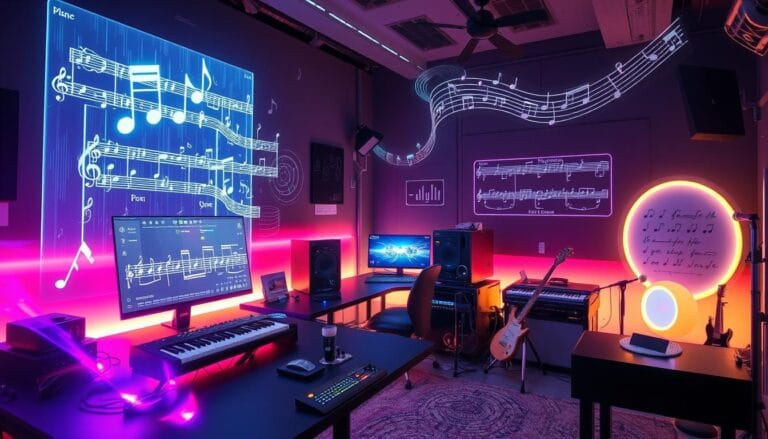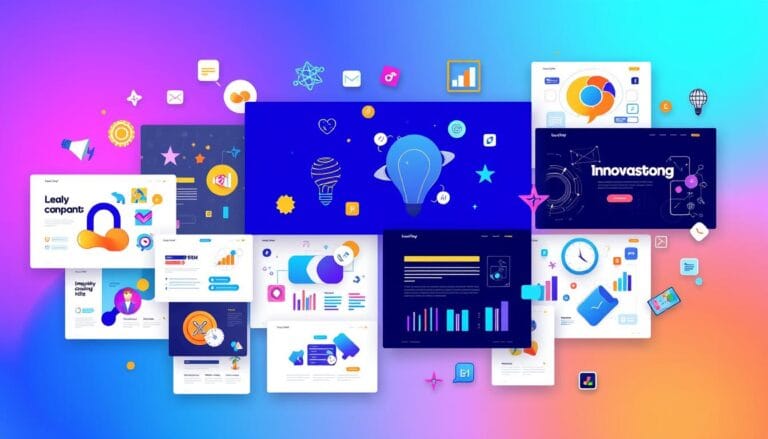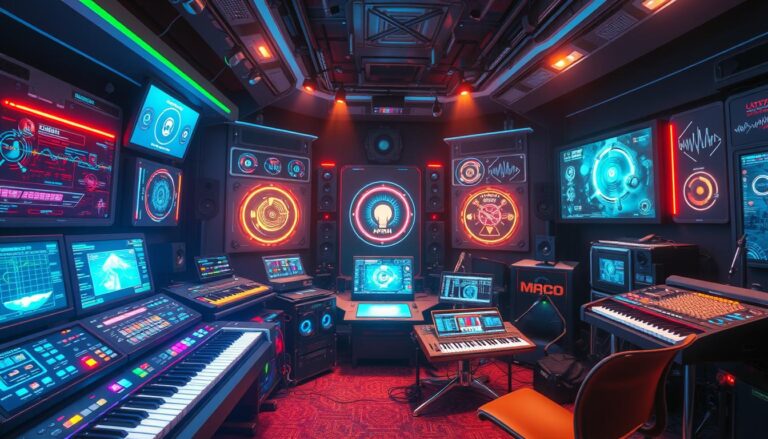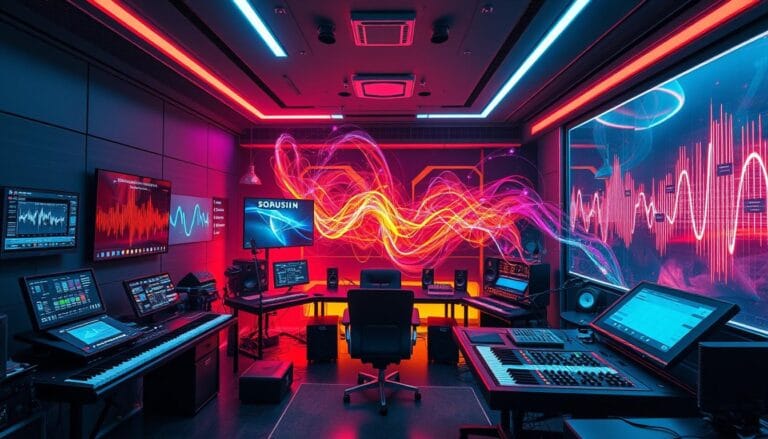Sonic Pi and ChatGPT: 10 Piano Prompts for Music Creation
Sonic Pi and ChatGPT: Unlock Amazing Piano Sounds with 10 Creative Prompts
Thank you for reading this post, don't forget to subscribe!Sonic Pi and ChatGPT: Unlock Amazing Piano Sounds with 10 Creative Prompts
I’ve always loved music and how technology can change it. AI tools like Sonic Pi and ChatGPT are now helping musicians create. We’ll see how these tools can help you make amazing piano music.
Today, using AI for music is a big deal. It’s great for both new and experienced musicians. Sonic Pi and ChatGPT make it easy to start making music. They work together to help you make music that stands out.
Table of Contents
Introduction to AI-Powered Music Generation
Artificial intelligence (AI) is changing music creation. Tools like Sonic Pi and ChatGPT are making it easier to create music. They open up new ways to express creativity and explore music.
Understanding the Basics of Music Programming
AI music generation starts with music programming basics. You need to know about rhythm, melody, and harmony. Learning these helps you use AI tools to make unique music.
Getting Started with Sonic Pi Installation
Sonic Pi is a great tool for beginners and pros. It lets you write code and make music live. Just download and install it to start your musical journey.
Setting Up ChatGPT for Music Creation
ChatGPT is another powerful tool for music. It uses natural language to help with music ideas. To use it, create an account and learn its features.
Exploring AI music generation is exciting. Try new things and see what you can create. With practice, you can make music that stands out.
| AI Tool | Key Features | Use Cases |
|---|---|---|
| Sonic Pi |
|
|
| ChatGPT |
|
|
Creating Simple Melodies with Sonic Pi and ChatGPT
Sonic Pi and ChatGPT are a great team for making music. Sonic Pi lets you create sounds with AI. ChatGPT helps by suggesting chords, melodies, and tempo changes for free.
To start, use ChatGPT to come up with chord ideas and melodies. Just tell it what kind of music you want, and it will give you ideas. Then, use Sonic Pi to turn those ideas into music.
- Try out ChatGPT’s music features to find chord progressions and melodies that fit your vision.
- Use Sonic Pi’s easy interface to make the AI’s ideas into music, adding your own twist.
- Play with Sonic Pi’s big library of sounds to make your music unique.
Together, Sonic Pi and ChatGPT open up new ways to make music. They let you create melodies that go beyond regular music. Use these tools to let your music dreams come true.
| Feature | Sonic Pi | ChatGPT |
|---|---|---|
| Chord Progressions | ✓ | ✓ |
| Melody Generation | ✓ | ✓ |
| Tempo Adjustments | ✓ | ✓ |
| Sound Effects | ✓ | – |
| Audio Editing | ✓ | ✓ |
By using Sonic Pi and ChatGPT together, you can explore new ways to make music. They help you create melodies that go beyond what’s usual. Let these tools help you make your music dreams come true.
“AI-powered music creation is changing how we make music. Sonic Pi and ChatGPT are leading this change. They help musicians and creators make new and exciting music.”
Understanding Music Scales and Chord Progressions
Exploring ai sound design tools, Sonic Pi, and ChatGPT requires knowing music scales and chord progressions. These basics help you make music that sounds great and moves people.
Minor Pentatonic Scale Basics
The minor pentatonic scale is key in music making. It’s a five-note scale that gives your music a special feel. Learning it helps you create melodies that touch the heart and make music that flows well.
Implementing Different Musical Modes
There’s more to music than just the minor pentatonic scale. Musical modes like Dorian, Mixolydian, and Phrygian add depth to your songs. Using Sonic Pi and ChatGPT helps you explore these modes and make your music stand out.
Working with Complex Chord Structures
Advanced chord progressions can make your music sound even better. Learning about extended chords, secondary dominants, and modal interchange opens up new sounds. ai sound design tools and ChatGPT make it easy to use these in your music.
Knowing music scales and chord progressions opens up a world of creativity. With Sonic Pi and ChatGPT, you can turn your musical ideas into reality. Your melodies and harmonies will move and inspire your audience.
Generating Percussion and Rhythm Patterns
Creating music is more than just melodies. The rhythm is key to a great song. AI tools like Sonic Pi and ChatGPT make it easy to create catchy beats and rhythms.
Sonic Pi has a wide range of drum samples. You can use kick, snare, hi-hats, and cymbals to make your music sound amazing. ChatGPT helps you come up with new rhythmic ideas, giving you ideas for your beats.
Start by learning the basics of percussion. Know how each drum works and how they fit together. Try different rhythms and speeds to make your music lively and engaging.
- Check out Sonic Pi’s huge drum sample library.
- Use ChatGPT to think up cool rhythms and drumming styles.
- Play with different drum sounds to create a strong beat.
- Try out polyrhythms and tempo changes for more interest.
- Keep working on your drumming skills to make your music better.
| Drum Element | Purpose | Sonic Pi Syntax |
|---|---|---|
| Kick Drum | Provides the low-end, foundational beat | sample :bd_haus |
| Snare Drum | Adds emphasis and backbeat to the rhythm | sample :sn_dub |
| Hi-Hats | Contributes to the rhythmic texture and groove | sample :drum_cymbal_closed |
| Cymbals | Enhances the overall percussion palette | sample :drum_cymbal_open |
Learning percussion and rhythm opens up new creative paths. Use Sonic Pi and ChatGPT to make music that grabs people’s attention.
Advanced Effects and Sound Manipulation
As you explore sonic pi coding for music, you’ll find many advanced sound techniques. These can make your music more exciting. Learn to create sound effects with ai and make your soundscapes come alive.
Implementing Reverb and Delay
Reverb and delay can make your music sound bigger and more interesting. In Sonic Pi, it’s easy to add these effects. Try different settings to change the mood of your music.
Creating Dynamic Sound Textures
You can also use ai to make complex sound textures. Try granular synthesis, wavetable modulation, and additive synthesis. These techniques can create sounds that change and grow.
Experimenting with Audio Filters
Audio filters are a key part of sonic pi coding for music. Use low-pass, high-pass, band-pass, and notch filters to change how sounds sound. Play with different filters and modulations to find new sounds.
Learning these advanced techniques will help you make sound effects with ai that are deep and emotional. Sonic Pi offers endless possibilities for your music. Start exploring and see where it takes you.
Live Looping and Performance Techniques
Discover the magic of real-time music creation with Sonic Pi and ChatGPT. Learn to blend beats, melodies, and soundscapes seamlessly. Explore live performance techniques to make your music come alive.
Sonic Pi is your tool for live looping. Its easy interface lets you create and layer loops. Use concurrency and variables to make your music complex and engaging.
ChatGPT can boost your live shows. It can give you new ideas and phrases to add to your performances. Let ChatGPT inspire you to explore new musical paths.
Whether you’re experienced or new to music, Sonic Pi and ChatGPT offer endless possibilities. Let your creativity shine and amaze your audience with AI-powered music.
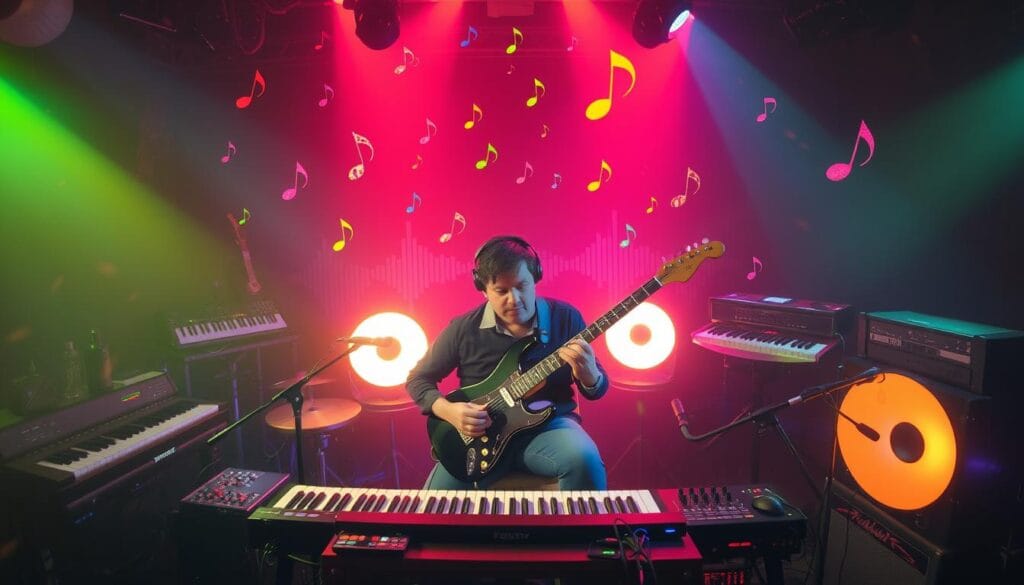
Live looping and performance techniques are exciting. Use Sonic Pi and ChatGPT to create unforgettable shows. Your audience will be amazed by your live, AI-generated music.
Composing Complex Musical Arrangements
Exploring complex musical arrangements is exciting, thanks to AI tools like Sonic Pi and ChatGPT. These tools help create detailed, layered music that grabs the listener’s attention.
Multi-threaded Music Programming
Sonic Pi shines with its multi-threaded music programming. It lets you mix different musical parts at once. This way, you can build your music, adding layers and blending sounds smoothly.
Layering Different Musical Elements
With Sonic Pi and ChatGPT, layering music is easy. You can mix various sounds, from eerie atmospheres to strong beats. These tools let your creativity shine, making your music reach new heights.
Creating Musical Transitions
Smooth transitions keep your music interesting. Sonic Pi makes it easy to change sounds and chords smoothly. ChatGPT can even suggest new ways to connect your music, adding surprise and excitement.
Learning to program, layer sounds, and create smooth transitions can make your music more complex and sophisticated. Use Sonic Pi and ChatGPT to reach your full potential as a musician.
Troubleshooting Common Coding Issues
Starting with sonic pi coding for music and ai music creation can be exciting. But, you might hit some coding bumps. Don’t worry, with a bit of troubleshooting, you can get past these and make amazing music.
One common problem is syntax errors. These can happen if you type something wrong or forget a comma. To fix them, go through your code slowly. Make sure each line is right. If you’re stuck, ChatGPT can help find and fix these errors.
Another issue is when your music starts to slow down. This can happen as your projects get bigger. To fix this, try using audio samples, optimizing loops, and managing threads. This will make your music play smoothly.
Lastly, don’t be scared to try new things and learn as you go. Making music with code is a fun and rewarding adventure. If you run into problems or have questions, look for help online. You can find tutorials, forums, and communities dedicated to sonic pi and ai music creation.
“Embrace the journey, and let the music be your guide.”
Remember, fixing problems is all part of the creative journey. Keep trying and learning, and you’ll master sonic pi coding for music and ai music creation.
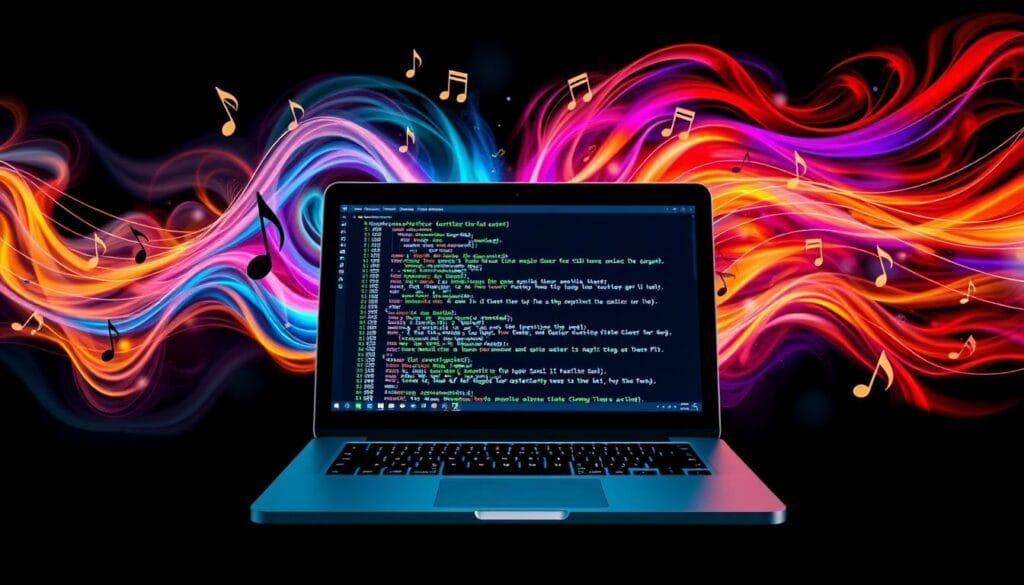
| Troubleshooting Tip | Description |
|---|---|
| Syntax Error Checking | Carefully review your code for any typos, missing punctuation, or incorrect formatting. |
| Performance Optimization | Explore techniques like audio sampling, loop optimization, and thread management to improve your code’s efficiency. |
| Community Support | Reach out to online forums, tutorial videos, and the sonic pi and ai music creation communities for guidance and troubleshooting assistance. |
Exploring Creative Music Programming Possibilities
In music creation, the possibilities are endless. AI tools like Sonic Pi and ChatGPT open up new creative paths. They let you explore and innovate in music programming.
Generative Music Concepts
Generative music is an exciting area. AI algorithms create music that changes and adapts. Imagine music that changes based on your mood or the environment.
This type of music offers a unique experience. It combines creativity and technology in a special way.
Algorithmic Composition Techniques
AI can also help with music composition. You can use AI to create complex music arrangements. This includes everything from chord progressions to percussion patterns.
With Sonic Pi and ChatGPT, you can explore music in new ways. These tools are great for both experienced composers and newcomers. They let you create sound effects with ai and generate music tracks for free.
“The true sign of intelligence is not knowledge but imagination.” – Albert Einstein
Conclusion
In this article, you’ve seen how artificial intelligence meets music and creativity. You’ve learned about Sonic Pi and ChatGPT. These tools let you create, change, and play music in new ways.
You’ve gone from making simple tunes to complex songs. You’ve mixed AI music making with music basics like scales and rhythms. This mix has opened up many creative paths for you.
Keep playing with ai sound design tools and free music tools. The real magic is in mixing tech skills with your creative ideas. Don’t be afraid to try new things and let your imagination run wild. This is how you explore the limits of music creation.
FAQ
What is the purpose of this guide?
What are the basics of music programming covered in this guide?
How can I use Sonic Pi and ChatGPT to create simple melodies?
What music scales and chord progressions are covered in this guide?
How can I use Sonic Pi and ChatGPT to create percussion and rhythm patterns?
What advanced sound manipulation techniques are covered in this guide?
How can I use Sonic Pi and ChatGPT for live looping and performance techniques?
How can I compose complex musical arrangements using Sonic Pi and ChatGPT?
How can I troubleshoot common coding issues when using Sonic Pi?
What are the creative music programming possibilities using Sonic Pi and ChatGPT?
Source Links
Sonic Pi Official Documentation: Comprehensive guides and tutorials on using Sonic Pi for music creation. Available at sonic-pi.net.
OpenAI API Documentation: Explore OpenAI’s API capabilities for creative AI applications at OpenAI API Documentation.


